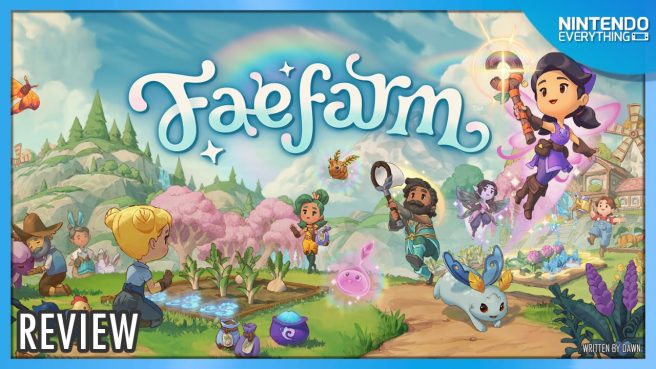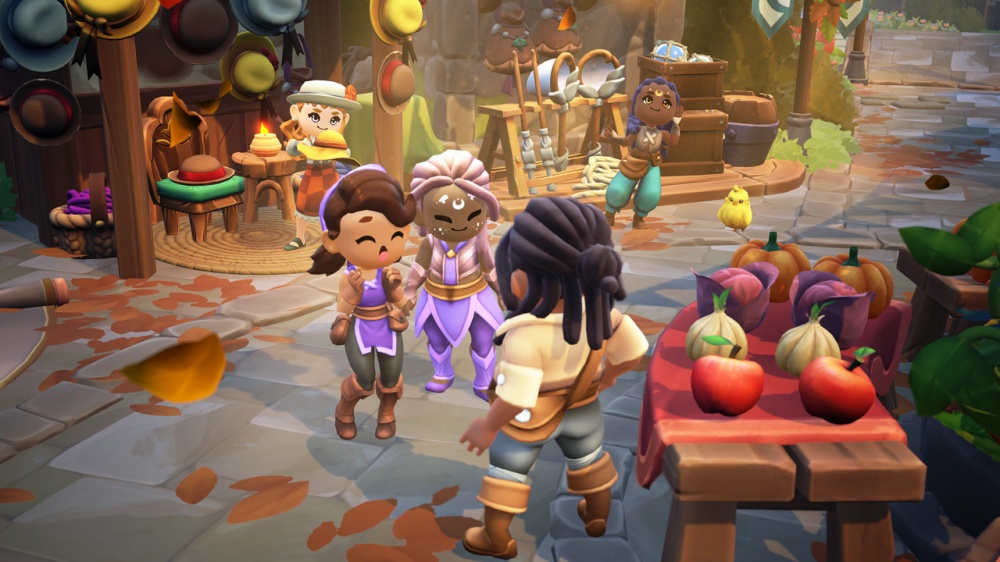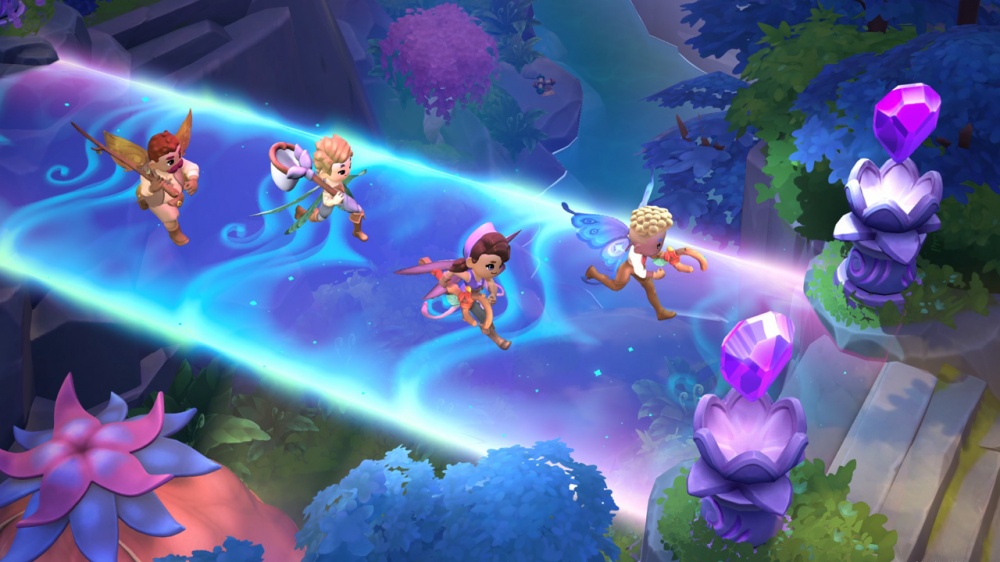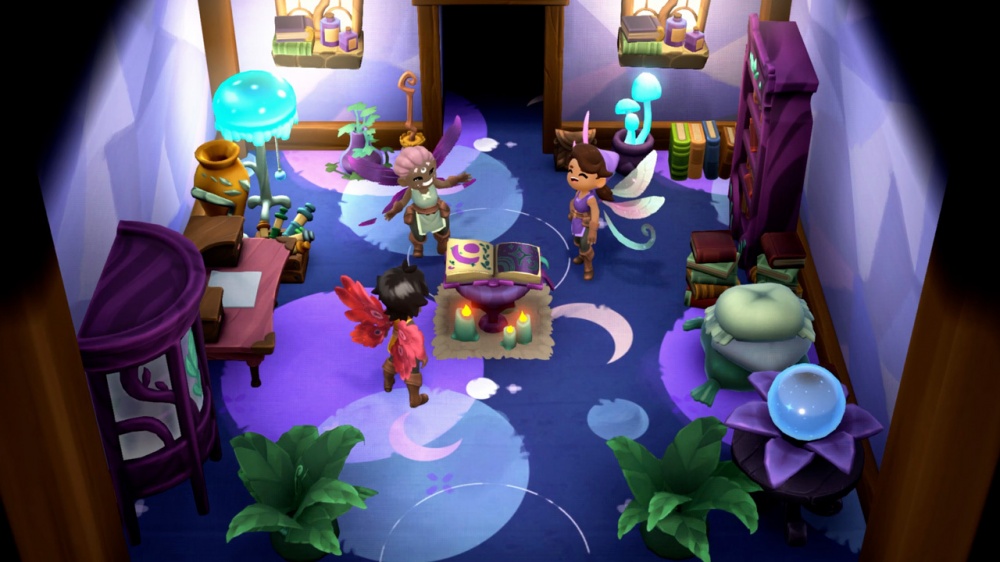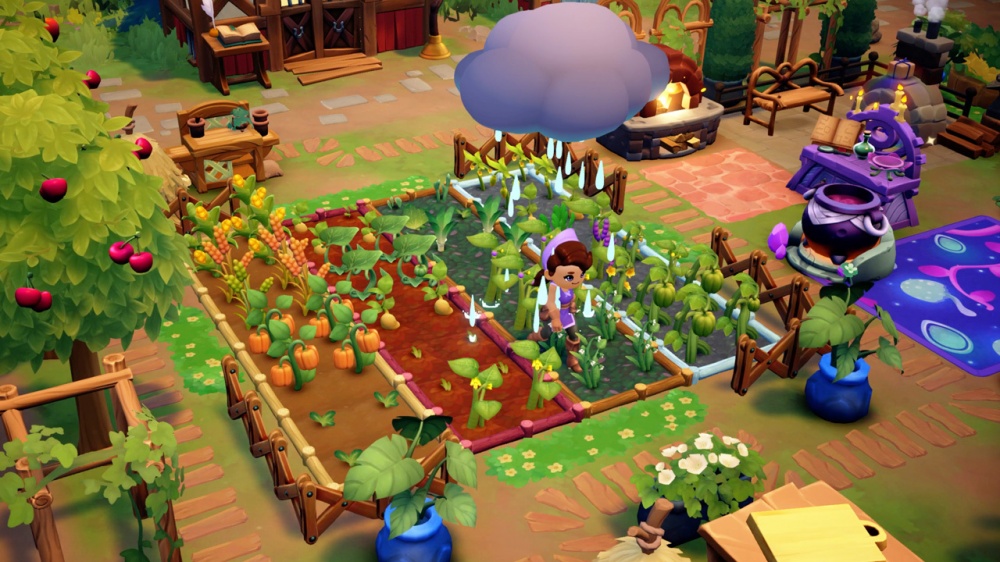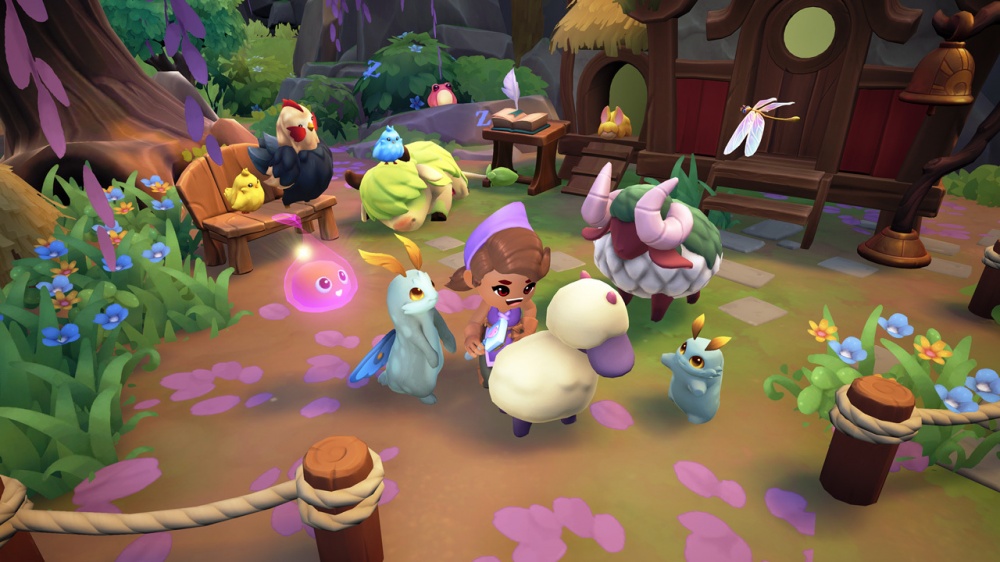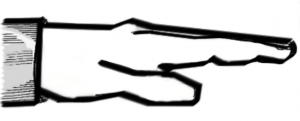System: Switch
Release date: September 8, 2023
Developer: Phoenix Labs
Publisher: Phoenix Labs
The farming/life sim genre has exploded in recent years, and with an abundance of high quality titles now available on Switch, it is becoming increasingly difficult for new entrants to stand out from the crowd. Fae Farm, which comes from Phoenix Labs, is the latest to have gathered some attention prior to its launch thanks to its magic-focused premise, RPG elements, and quality-of-life features that make the pains of the genre more bearable and accessible. While Fae Farm takes several steps in the right direction towards this end, there are some design choices that make the overall experience less magical than it could have been.
Fae Farm begins with your character finding a message in a bottle, which comes from a faraway land in need of a brave and courageous soul with the promise of a warm welcome and a home should any choose to accept. They immediately set out for adventure, only to find themselves caught in a storm and shipwrecked on Azoria. All is not well in Azoria, as dangerous whirlpools prevent anyone from leaving, thick fog blankets the land, and natural disasters such as blizzards and volcanoes have thrown the land into turmoil. Despite this, the inhabitants all seem quite relaxed about it and unwilling to do anything themselves, so it’s up to you to restore balance, uncovering the various mysteries of the land. Although it isn’t a particularly high stakes narrative filled with twists and turns that will have you remembering it for years to come, I found Fae Farm’s story to be surprisingly involved and enjoyable, serving as a nice backdrop for gameplay. Acquiring new magic spells, recipes, and items as part of the story gave them more meaning than simply acquiring them because I’d reached a gameplay milestone, and it served as a great vehicle for expansion of the world and the gameplay.
Quest-based progression is at the heart of Fae Farm, and this makes the opening hours far less tedious than other life sims, which tend to either leave you to figure things out for yourself after that initial introduction or drown you in generally unhelpful tutorials. Fae Farm gives you a series of short main story quests for the basics like farming and fishing, and then leaves the non-essential tasks such as cross-breeding flowers to side quests, which you can completely ignore if you choose. The game strikes an excellent balance between giving you a clear objective to work towards and leaving you entirely to your own devices, and although you will need to complete story quests to unlock more advanced tools, game mechanics, and areas, you’re not forced to do this at any particular pace. I was well into summer before reaching the game’s fourth chapter, having spent most of my time building up my cash reserves, and could have easily gotten there much sooner.
Fae Farm keeps to its own clock, with a day in-game being shorter than in real life. The day starts at 6 AM, but rather than have your character pass out and wake up late the next day if you stay up too late, it adopts the no less aggravating practice of unceremoniously booting your character back home and ending the day the second the clock strikes midnight, regardless of what you happen to be doing at the time. This was something I didn’t care for, especially when exploring dungeons, and made me very conscious of the time as the day wore on – something that seems counterintuitive to a genre which places a high emphasis on freedom of choice.
One of the aims of Fae Farm was to address the more time-consuming aspects of the life sim genre, and in many aspects it does an excellent job. The majority of your tools are context sensitive, so all you need to do is face the object you want to interact with and the tool you need for the job will be selected automatically. This can be a little awkward when different objects are clustered closely together (more than once I found myself mining a rock when I wanted to cut down a tree, for example) but eliminates time spent in menus picking the right tool. Your fishing rod, bug catching net, and magic staff are all separate from your main tools, but are easily accessible by pressing the shoulder buttons, letting you swap out at a moment’s notice. Using a context sensitive tool costs a small amount of stamina, and once your stamina is depleted your character will be unable to do any other tasks until you fill it again by eating something. Rather than force you into your inventory to pick a food item, the game will give you a prompt to press the ZR button to eat something, and will also do this if you’re running low on health or mana and have items that can restore them. It’s a small feature, but a nice one, and helps keep gameplay flowing with fewer interruptions.
Navigating the world of Azoria is also quick and convenient. Whilst you won’t be able to utilize Waypoints, the game’s fast travel system, until later in the game, bringing up the world map will display icons of all the NPCs as well as the main locations, and selecting one will give you a pointer that will lead you directly to them. Given that most NPCs will move around during the day this is a hugely helpful feature, and one I appreciated enormously when playing. The world map also highlights when new quests are available and which character is offering them, letting you easily pick things up. The game is surprisingly free with traversal as well, letting you move freely anywhere within the boundaries of the map. The developers clearly anticipated the potential problems that could have arisen because of this too, with a “Help, I’m Stuck” option in the menu that will place you back into an area you can move in if you select it. I only needed to use this feature once during the game, when I accidentally placed myself inside a Food Prep Table I’d crafted, and it immediately placed me next to it, saving the need to reload and giving me a small chuckle that it had happened at all!
Magic also plays a huge role in Fae Farm, functioning as a more creative way to engage with the farming side of the game and make the simple combat more exciting. You will unlock spells for your magic wand as you progress the story, but higher grade tools also have their own magic that you can use. Mostly the spells involve doing more of whatever that tool was designed for (for example, the pickaxe can be charged to break multiple rocks at once in an area) but the end result is quite satisfying to watch and it makes each task easier to carry out. It adds a unique flavor to the game that ties in nicely to the narrative, and each new spell you unlock makes it feel as though your character is developing and progressing their skills.
Something unique to Fae Farm of particular note is the added utility in decorating your home. Each piece of furniture you can place in your house will increase one of your three stats: health, stamina, and magic. It presents an added layer of meaning to decorating that isn’t present in other life sims: choosing between furniture that was aesthetically pleasing or increased my character’s stats isn’t a choice I was expecting to have to make, and gave a more personal touch to my home than it otherwise would have been had I based my choices purely on aesthetics.
There are also several dungeons in the game, which you will explore during the story. These are fairly simple multi-floored areas where you either need to uncover the switch to open the door to the next floor, or place a seal in the plinth at the entrance, unlocking the door and letting you fast travel to that floor if you re-enter the dungeon. Dungeons are populated by enemies called Jumbles, which all have a design that fits the theme of the dungeon (the first dungeon, Saltwater Mines, has Jumbles that look like sentient treasure chests and anchors, for example) and they’re all quite creative. Combat is straightforward, only needing you to avoid clearly telegraphed attacks and hit them in return with your magic staff, but is quite satisfying despite that, and floors are never so populated with enemies that it becomes a chore to get rid of them all before you look for the hidden switch to open the next floor. These are a nice break from the life sim elements and make the game feel like a light action RPG at times.
Unfortunately, despite its brilliantly interconnected systems, Fae Farm makes crafting needlessly complex, with a frankly ridiculous number of different stations you’ll need to create to do a single task. For example, you can prepare ingredients and meals at a Cooking Fire, Beverage Station, Food Prep Table, Cooking Hearth, or Artisan Table, and each of these has different recipes attached to it. It’s a lot to keep track of, and although the game’s Almanac is highly comprehensive and breaks things down in a clear and concise fashion, I often felt like the time I wasn’t spending in menus changing my tools around I was instead spending checking my stations or the Almanac trying to find out where I could craft something and what I’d need to do it.
Crafting is also automated, meaning that you will be spending a lot of time waiting for things to be done, and in a game that forcibly ends the day at midnight this creates some irritating pacing issues with the gameplay. More than once I found myself wasting time away by fishing (which itself is not an enjoyable task) whilst I waited for seals to finish crafting so I could continue exploring a dungeon, or for ingots and lumber so I could upgrade my tools or craft some decorative items.
Fishing is also more complicated than the standard practice of just casting your line and pressing a button to reel the fish in when it bites. Fae Farm instead gives you a tug-of-war minigame where you have to hold the button down to reel the fish in when it isn’t pulling on the line, and it goes on for far longer than it needs to, as the fish will yank the line almost back out to where it started at frequent intervals. Trying to reel it in when it pulls will snap the line, sending you flying into the water after it, an animation that starts off as entertaining but quickly becomes tiresome. Enabling the “Simple Fishing” option from the menu means you only need to press the button once to pull or slacken the line, but it unfortunately doesn’t make the minigame any less tedious.
For all the life present in the world of Fae Farm, this cannot be said of the denizens that inhabit it, and one of the weaker elements of the game is its cast and the way you interact with them. What I found most disappointing about NPC interaction was that there was no real benefit to it: the cutscenes that you get from deepening your bond with characters do provide a little insight into their personalities, but there is nothing outside of these short scenes to make talking to these characters worth your time. Upon unlocking personal quests I was immediately bombarded by NPCs all asking for exactly the same item, despite each of them having clearly stated preferences in their bios. Some NPCs will give you Job Quests, but these are tied to your activities and not the NPCs themselves, and doing them doesn’t impact your relationship with the character in any way. Marriage has no notable impact on their behavior other than to have them on your farm occasionally, and there are no character-driven side stories. Every character has their own unique visual appearance, and the cast is quite large, but they are all equally bland and lifeless.
Fae Farm also suffers from a number of technical issues at present, ranging from relatively harmless animation glitches to agonizing frame rate drops. Almost every time I opened the world map I would be greeted by extreme levels of slowdown as the game loaded up the NPC icons, and there were often noticeable pauses when opening and closing the menu, or when turning in a quest. Load times were also frequently long enough to be noticeable. These incidents weren’t enough by themselves to ruin my overall enjoyment of the game, but I also ended up having to restart the game entirely after my magic staff completely disappeared when I upgraded my fishing rod, leaving me unable to use magic and (as far as I could tell after speaking to every other NPC I could find) unable to buy another staff to replace it. Whilst the game runs relatively smoothly on the Switch for the most part, these constant interruptions and optimization issues can be highly distracting, and there is room for improvement here.
There is a lot to like about Fae Farm, and it makes several positive quality-of-life improvements to the genre that make it a joy to play most of the time. Its quest-based approach to progression provides structure without feeling too rigid, giving you a goal to work towards but letting you do so at your own pace. Context-sensitive tools are something that should have been implemented as a standard practice in life sims years ago and work beautifully here in making the day-to-day tasks less of a tedious grind, and the magic twist that Fae Farm places such a heavy emphasis on makes it feel unique amongst its peers. The game does an excellent job in bringing you into the world of Azoria, and making that world feel alive and evolving as you progress through the story.
Unfortunately this ease of access that Fae Farm provides is not uniform across the board, and while the game takes several steps in the right direction towards making the more tedious aspects of the genre more accessible and enjoyable, it also makes certain elements, such as fishing and crafting in particular, far more complicated than they need to be. You might not be spending time meticulously swapping out your tools, but you are going to have to use five different crafting stations to make food, and you’re going to have to wait for it to finish. Performance issues are also a fairly constant presence, and although the glitch I experienced during my time with the game may have been an extremely unfortunate isolated incident, the possibility that this or similar glitches could happen to other players exists and is something to keep in mind. For fans of the genre interested in the communal aspect of life sims, Fae Farm’s bland cast and lack of meaningful relationship elements will also disappoint.
The Verdict
Fae Farm is definitely a game to keep on your radar. With future content updates already planned, and patches that will no doubt address the performance issues, this is an excellent game weighed down by a handful of problems that mostly feel more like minor issues than they do unfixable flaws. But because of these at present it’s a very tough sell, especially at its higher than average for the genre price point. With the abundance of life sims available on Switch, your time and money may be better spent elsewhere – at least at launch.
Fae Farm review copy provided by the publisher for the purposes of this review.
